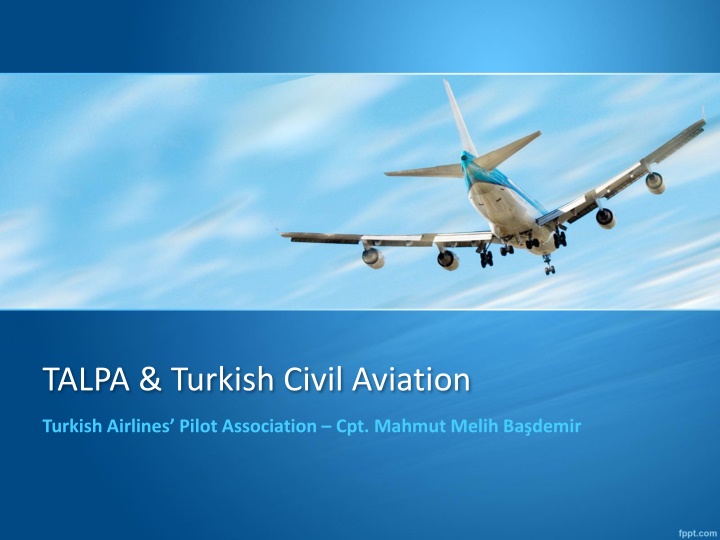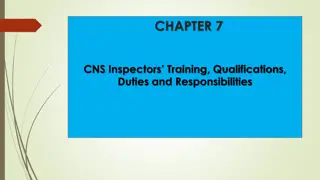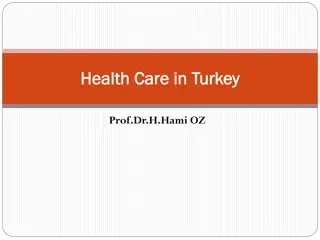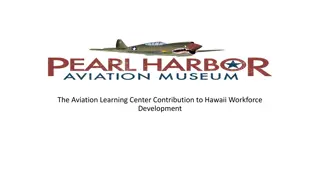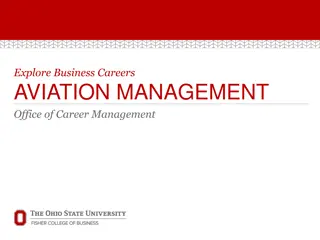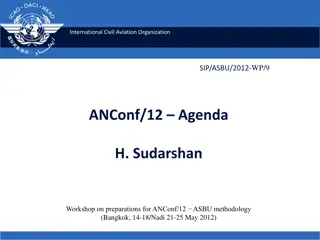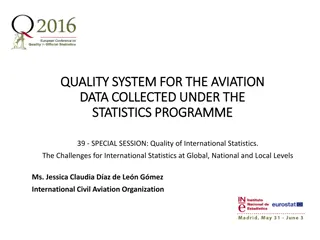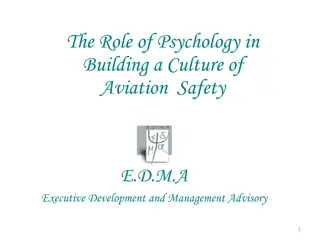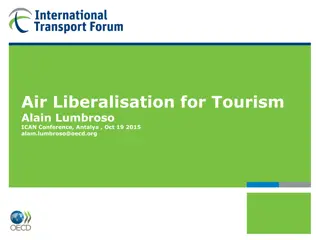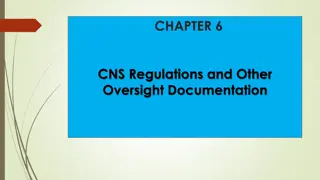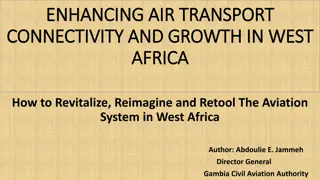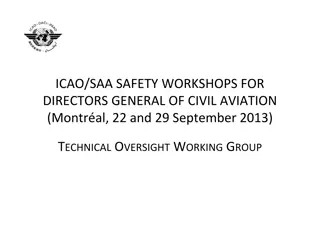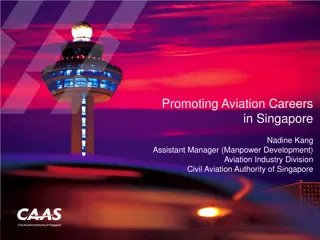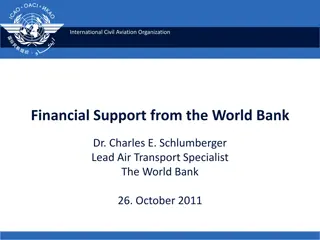Evolution of Civil Aviation in Turkey: A Historical Overview
Turkish civil aviation has a rich history dating back to the early days of State Airlines Administration in 1933. Over the years, significant milestones such as the founding of Turkish Airlines, privatization efforts, and the emergence of new airline companies have shaped the industry. The Turkish Airlines Pilot Association (TALPA) has played a crucial role in representing and supporting pilots, reflecting the growth and changes within the sector.
Download Presentation

Please find below an Image/Link to download the presentation.
The content on the website is provided AS IS for your information and personal use only. It may not be sold, licensed, or shared on other websites without obtaining consent from the author.If you encounter any issues during the download, it is possible that the publisher has removed the file from their server.
You are allowed to download the files provided on this website for personal or commercial use, subject to the condition that they are used lawfully. All files are the property of their respective owners.
The content on the website is provided AS IS for your information and personal use only. It may not be sold, licensed, or shared on other websites without obtaining consent from the author.
E N D
Presentation Transcript
TALPA & Turkish Civil Aviation Turkish Airlines Pilot Association Cpt. Mahmut Melih Ba demir
TALPA & Civil Aviation in Turkey 1933 State Airlines Administration was founded with 5 planes, 7 pilots and 28 seat capacity 1945 52 planes & 845 seat capacity; Turkey became a member of ICAO 1947 First international Voyage; Ankara-Istanbul-Athens 1953 Ye ilk y International Airport was built 1956 By law State Airlines Administration changed into Turkish Airlines Inc. (THY) ; Turkey became a member of ECAC 1958-1996 Pilots of Turkish Airlines Society Within Turkish Airlines Inc. Was founded to meet the social and cultural needs of THY s pilots and to support their professional development 1962 The first and the only work union of the civil aviation in Turkey was founded; Hava- . The union has an organic link to THY actually. Then the only airline in Turkey was THY therefore the members of the union were only THY workers. This is still the case today.; in 1964 there were 34 planes, 1120 seat capacity
TALPA & Civil Aviation in Turkey 1967 The first international jet Flight Ankara Istanbul Brussels 1982 27 planes, 3909 seat capacity and total of 5735 THY personnel 1983 Civil Aviation Law became effective which privatized Turkish Civil Aviation 1989 The second Airline was founded, SunExpress a co-foundation of THY and Lufthansa 1990 The third Airline was founded, Pegasus with 2 air planes 1996-2008 Airlines Pilot Association To be able to represent all the pilots in the sector Pilots of Turkish Airlines Society terminated itself and Airlines Pilot Association was founded. There were 904 members in total of which 517 was from THY in 1996. 2003 Re-privatization allowing airline firms to be able to enter more internal routes thus the market share of THY dropped from 97.79% to 71 % in 2004 2008-Present Turkish Airlines Pilots Association The total members were 1216 of which 889 was from THY in 2008 The total members are 3530 of which 3156 is from THY in 2017
The CPL & ATPL licenses and TALPA Membership CPL&ATPL Licenses & TALPA Membership 8,000 7,502 7,000 5,748 6,000 5,327 5,000 4,667 4,428 3,863 4,000 2,895 3,000 2,000 1,319 1,239 1,000 0 2003 2010 2016 CPL&ATPL licence number Active CPL&ATPL licences TALPA Members
Airline Statistics 2003 2010 2016 Plane 162 332 504 Airlines 13 16 13 Passenger Traffic 34.443.000 102.800.000 173.624.000 Civil Airports 30 40 55 Seat Capacity 27.599 56.638 100.365 Turnover 2,2 million $ 12 million $ 23.4 million $* Countries with which Turkey has airline agreements 81 111 168 Mutual negotiations 7 29 32 *Figure for 2015
TALPA Turkish Airlines Pilots Association Works closely with government officers and related bodies in order to prepare the necessary rules and regulations needed by the pilot profession Pilot Union Law Through intense lobbying in the last version of the MED regulation have managed to shorten the period necessary for the pilots with health problems to get results from Turkish NAA Have attended meetings with Turkish NAA about the new FTL regulation Gives consultancy to unemployed pilots or to pilots who have problems with their firms Organizes workshops in order to provide a medium to be able to share problems and come out with solutions regarding pilots Follows-up the international safety standards developments and informs it s members about these developments Represents Turkey in international organizations regarding pilot profession Emergency center for pilots facing major incidences or accidents Publishes Kokpit ten Bak journal every three months Center for ICAO English Proficiency Tests for pilots
General Problems of Turkish Civil Aviation There is a union for airline workers in Turkey. This union is Hava- Union and only THY workers can be members to the union and the union represents not only pilots but also the cabin crew and the other workers in THY. According to the Turkish law pilot profession is not under the labor law but is subject to obligations law therefore pilots working in airlines other than THY do not have any rights as other workers do. The applications of the new FTL(EASA FTL 2016 compliant) has been a real cause of fatigue for pilots. Recently THY has violated the labor contract and revised the labor contract without getting the permission of Hava- . THY with this revision intends to put into force the standby time at hotels practice again. Very recently Turkish NAA has shorten the obligatory period of flight hours to become a captain. The obligatory period was 3 years of experience plus 4000 Flight hours. The new requirement is only 1500 Flight hours.
Active Pilots showing the number of pilots represented by the union Active Pilots / THY Pilots - Pilots represented by the union 6,000 5,000 4,000 615 2,113 4,468 3,000 2,000 3,248 2,315 1,000 859 0 2003 2010 2016 Other Airline Pilots THY Pilots
Plane Statistics 2010 vs. 2016 2010 Plane Numbers 2016 Plane Numbers Other, 56 Atlasjet, 25 MNG, 7 Other, 71 Onur Air, 25 THY, 153 Atlasjet, 15 G ne Express, 49 MNG, 10 THY, 308 Onur Air, 28 Pegasus, 70 G ne Express, 28 Pegasus, 27 THY Pegasus G ne Express THY Pegasus G ne Express Onur Air Onur Air MNG Atlasjet MNG Atlasjet Other Other
Geographic Risks of Turkish Civil Aviation Between Europe, Asia and Middle East Turkey has a geopolitical importance. It is an important hub for transportation From 2003 to 2014 the sector grow on average 13,7% each year, compared to a growth rate of 5,7% per year for the Aviation industry globally Passenger numbers rose by an average of 16% a year from 2003 to 2013 According to ICAO statistics in 2016 Turkey is the 10thfor RPK (Revenue Passenger Kilometer) Atat rk Airport in passenger numbers is the 10thin the world and the 3rdin Europe in 2016 In 2013 the passenger number was over 150 million; in 2036 it is expected to be 196 million. Turkey faces some competition from Gulf countries for its status as a transport hub. However, Gulf countries need wide-body aircraft if they are to carry passengers from Europe to Asia, whereas more than 40% of international traffic from Turkey can be reached using narrow body aircraft. Narrow body aircraft provide greater flexibility in terms of Operations. There are some risks; the exchange rate volatility, economic instability, worsening security conditions, the threat of terrorism from surrounding countries
Istanbuls Third Airport Annual Capacity: 90 million passengers (2018) Target: 150 million passengers (2028) Runways:6 Terminals:4 Taxi ways:16 Passenger Bridge:280 Airplane Park Capacity:500 Terminal Building:3 Air Traffic Control Tower:3 Total Area: 76 million meter square (about 15.000 football stadiums) Apron Area:6,5 million meter square Predicted worker number after completion: 120.000 After completion it will serve over 150 Airlines and to more than 350 destinations Environment friendly airport, will have LEED certificate An airport city is being built with connections to the central areas of Istanbul
Slide Title Product A Feature 1 Feature 2 Feature 3 Product B Feature 1 Feature 2 Feature 3
